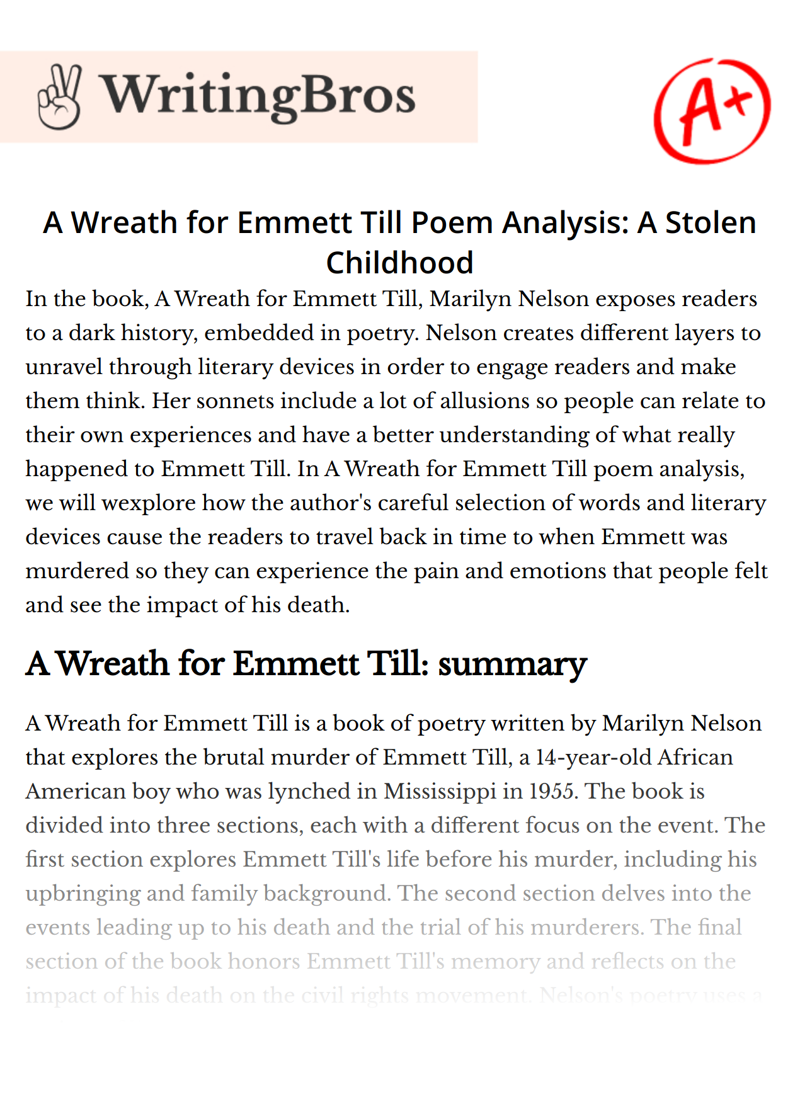A Wreath for Emmett Till Poem Analysis: A Stolen Childhood

Table of contents
- A Wreath for Emmett Till: summary
- Poem analysis and reflection
- References
In the book, A Wreath for Emmett Till, Marilyn Nelson exposes readers to a dark history, embedded in poetry. Nelson creates different layers to unravel through literary devices in order to engage readers and make them think. Her sonnets include a lot of allusions so people can relate to their own experiences and have a better understanding of what really happened to Emmett Till. In A Wreath for Emmett Till poem analysis, we will wexplore how the author's careful selection of words and literary devices cause the readers to travel back in time to when Emmett was murdered so they can experience the pain and emotions that people felt and see the impact of his death.
A Wreath for Emmett Till: summary
A Wreath for Emmett Till is a book of poetry written by Marilyn Nelson that explores the brutal murder of Emmett Till, a 14-year-old African American boy who was lynched in Mississippi in 1955. The book is divided into three sections, each with a different focus on the event. The first section explores Emmett Till's life before his murder, including his upbringing and family background. The second section delves into the events leading up to his death and the trial of his murderers. The final section of the book honors Emmett Till's memory and reflects on the impact of his death on the civil rights movement. Nelson's poetry uses a variety of literary devices, such as imagery, metaphor, and allusion, to paint a vivid picture of the events and emotions surrounding Emmett Till's murder.
Poem analysis and reflection
A moment that stopped me in my tracks while reading A Wreath for Emmett Till was in sonnet 2 when the author said, “pith outward, it has been slowly dying, pierced by the screams of a shortened childhood” (sonnet 2, line 13). Using personification, Nelson wrote this from the perspective of a tree who witnessed the murder of Emmett. This moment is so powerful because it emphasizes how brutal Emmett’s death was; the tree survived seasons of rain and droughts but was scarred by the murder. The tree is traumatized, it losts its innocence and childhood. This made me stop and think because for me, losing my childhood was getting my period or holding hands with a boy, but for the tree it was watching someone get murdered and its childhood was stolen. The tree is not able to move on and forget his death like many others did. The phrase, pith outward, describes how the tree dies from the center outward. This reminded me of the pain and sinking feeling you get in your stomach when you hear bad news or something that you wish you didn’t hear. This made me think of the immense pain that people who were a part of Emmett’s life must have felt.
Another powerful moment in this book was in sonnet 14 when the author said, “Like his gouged eye, which watched boots kick his face, we must bear witness to atrocity” (sonnet 14, line 1). The author leaves us with graphic image of Emmett’s gouged eye to remind us that things like this will continue to happen unless we speak up. The author implies that tragedy and evil are inevitable but we have a choice about how to handle them. This was a good conclusion to the collection of poems because it calls for justice. This made me feel empowered in a way because I didn’t want what happened to Emmett happen to anyone else and hearing his story encouraged me to stand up for any injustices that I might encounter.
Instead of discussing the murder of Emmett Till directly, Marilyn Nelson focuses more on the impact that it had. She makes us feel the pain of those who were affected by Emmett Till’s death through the tree. Then she makes us understand the need for justice by showing us the violence that Emmett, along with many others, endured. She used literary devices to personalize history so readers could connect with this tragic event and remember it. Words mattered in this poem because they made the reader experience emotions that newspaper articles and history textbooks do not convey.
References
- Nelson, M. (2005). A Wreath for Emmett Till. Houghton Mifflin Harcourt.
- Schraff, A. (2008). Emmett Till: The Murder That Shocked the World and Propelled the Civil Rights Movement. Enslow Publishers.
- Tyson, T. B. (2017). The Blood of Emmett Till. Simon & Schuster.
- Whitfield, S. J. (2011). A Death in the Delta: The Story of Emmett Till. Johns Hopkins University Press.
- Roberts, D. (2018). Killing Emmett Till. Simon & Schuster.
- Rollyson, C. (2019). Marilyn Nelson: A Critical Companion. University of South Carolina Press.
- West, M. L. (2008). Understanding Marilyn Nelson. University of South Carolina Press.
- Crowe, C. J. (2016). The Long Road to Freedom: An Anthology of Black Music. University of California Press.
- Rosenblatt, J. (2018). Emmett Till: The Murder That Shocked the World and Propelled the Civil Rights Movement. National Geographic Children's Books.
- Sitkoff, H. (2008). The Struggle for Black Equality. Hill and Wang.
Cite this Essay
To export a reference to this article please select a referencing style below

